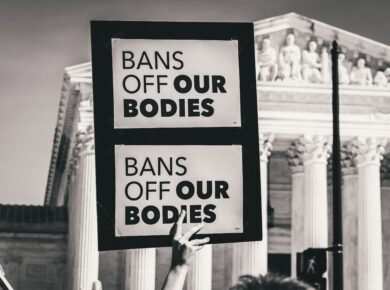Two F-22 Raptors fly over the Pacific Ocean during a theater security mission. A Royal Australian Air Force pilot assigned to the 90th Expeditionary Fighter Squadron at Andersen Air Force Base, Guam, has had the opportunity to fly the F-22 Raptor as part of a pilot-exchange program. (U.S. Air Force photo/Master Sgt. Kevin J. Gruenwald)
Disclaimer:This blog post solely reflects the opinion of the authors and should not be taken to represent the general views of IPPR’s management/ editorial team or those of fellow authors.
In the past thirty years, the United States has frequently used no-fly zones to intervene in foreign crises. The costs of these endeavors have been extremely limited. Memories of cost-free no-fly zones are leading people to recklessly promote a no-fly zone as a solution to the crisis in Ukraine.
As the war in Ukraine has escalated, so have the calls for NATO to impose a no-fly zone (NFZ) over the country. For the past three decades, the U.S. has been able to safely intervene in conflicts by establishing NFZs. However, these calls for establishing an NFZ are misguided, and rooted in a nostalgic desire to return to the era of cost-free U.S. interventions in humanitarian catastrophes. In the case of Ukraine, establishing a no-fly zone would be extremely reckless given the enormous stakes involved in a direct military confrontation between NATO and Russia.
The growing calls for a Ukrainian no-fly zone
Support for establishing a NFZ is closely linked to the progression of Russia’s invasion of Ukraine. As Russia began amassing troops and equipment along its border with Ukraine, few thought Russian President Vladimir Putin would actually make the calamitous decision to launch a full-scale invasion. As fears of an invasion grew, so did the pessimism that Ukraine was ill-prepared to face the massive onslaught Russia would soon launch. Most commentators and analysts did not predict Ukraine would be able to mount an effective resistance to the much bigger and better equipped Russian military. There were also fears that the West would be disunited on how to respond to the Russian threat.
On February 24, the worst-case scenario became reality as Russia launched a full-scale, unprovoked invasion of Ukraine. As shocking as the invasion itself was the swift and unified Western reaction to Russia’s aggression. Coordinated economic sanctions caused the ruble to lose nearly 50% of its value against the U.S. dollar. The Moscow Exchange suspended trading and has yet to reopen. Even more shocking was the determined resistance of Ukraine to Russia’s aggression. Despite months of what was supposed to be strategic preparation, Russia’s forces were taken aback by organized and determined Ukrainian resistance. Supply lines broke down and became easy targets for Ukrainian drones. Unsupported Russian paratroopers were quickly surrounded and destroyed. Ukrainian President Volodymyr Zelensky, a former TV comedian, has inspired his country and the world through his confident leadership. Fears of a quick Russian victory have given way to international admiration for the fierce and determined Ukrainian resistance.
As admiration of Ukraine’s resistance grew, so did the calls for the West to do more to support Ukraine, creating the discursive space for the NFZ to gain traction. On Monday, March 7, artists threw hundreds of paper planes in the Guggenheim Museum in New York to call for the U.S. to ‘protect the sky over Ukraine’. Over two dozen former U.S. national security officials signed an open letter calling for a limited NFZ over Ukraine. Kurt Volker, the former U.S. ambassador to NATO and special representative for Ukraine, said the U.S. should implement a NFZ to protect civilians. Former Russian chess grandmaster and human rights activist Gary Kasparov tweeted that if “NATO does not enforce a NFZ, the savages have won already”. Senior Conservative politicians in the UK have called for a NATO-enforced NFZ over Ukraine. Adam Kinzinger, a prominent former member of Congress, tweeted the U.S. should “declare a #NoFlyZone over Ukraine” in order to “Disrupt Russia’s [sic] air ops to give the heroic Ukrainians a fair fight”.
Past U.S.-backed no-fly zones and their success
The calls for a NFZ are closely linked with the past thirty years of relatively successful U.S.-led NFZs around the world. After the end of the Cold War in 1991, it was clear the U.S. military was without equals in the international arena. The collapse of the Soviet Union meant the risk of a local conflict escalating into nuclear war no longer existed. This perception was further validated by America’s overwhelming victory in the 1991 Gulf War against Saddam Hussein’s Iraq. The U.S. had the military and political dominance to intervene at-will around the world, mostly in the form of NFZs. After the U.S. victory in the Gulf War, America led an international coalition to enforce a NFZ to protect Iraqi Shiite’s in Southern Iraq and Kurds in the north. From 1993 to 1995, NATO enforced a NFZ in the Balkans to prevent Serbian war crimes against Bosnian Muslims. NATO enforced a NFZ in Libya in 2011 to prevent the forces of Libya’s then-dictator Muammar Gaddafi from massacring rebel fighters and civilians. In all three cases the NFZs were enforced with extremely limited U.S.and NATO losses.
The memories of successful past U.S.-led NFZs clearly influence current debate over a Ukrainian NZF. In contrast to U.S. military superiority, the opposing forces the U.S. faced were small, underdeveloped, and isolated. The U.S. and allied militaries could easily overwhelm and defeat Serbian, Iraqi, and Libyan air defenses. This was evident in the extremely limited U.S. and allied losses. This historical memory has created the impression of a NFZ as a practically cost-free option.
The issue of enforcement in no-fly zones
The fundamental problem with declaring a NFZ is enforcement. Enforcing a NZF requires shooting down enemy planes operating in the NFZ and destroying enemy air defenses. While in Bosnia, Iraq, and Libya, enforcement was extremely easy and practically cost-free due to their less-developed air defenses, Ukraine would be a very different case. The U.S. would have to shoot down Russian planes over Ukraine. Russia operates air defense missiles in Belarus and Russia that could shoot down any U.S. plane operating in Ukraine. Therefore, the U.S. would have to attack Russian military installations in Belarus and Russia. Russia’s air force and air defenses are far more advanced than America’s previous adversaries. It is likely that a high number of U.S. pilots would be killed. This would lead to public pressure to avenge dead Americans and push U.S. leaders to take even more escalatory steps such as attacking Russian ground forces.
Every time the U.S. has previously enforced a NFZ, the consequences were practically non-existent in terms of sustained losses. The terminology between those conflicts and now is the same. However, given the scale and equipment of Russian forces, a NFZ in this case will hold drastically more negative outcomes than anything the U.S. has previously experienced.
By John Morgan,
John Morgan is a final year Politics and International Relations student at UCL







